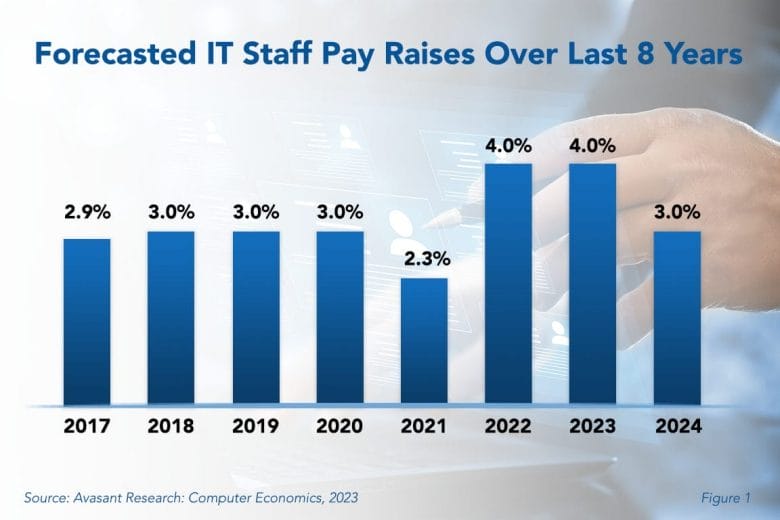Despite lingering questions about the economy, unemployment remains at low levels and inflation is coming under control. We anticipate modest upward pressure on IT personnel wages in 2024. Overall, our IT Salary Report 2024 anticipates that average wages for IT workers will rise 3.0% in 2024. This is lower than the 4.0% we projected the past two years, but it still shows a strong IT job market, especially considering a fair number of high-profile layoffs in the tech industry earlier in 2023.

Figure 1 is an expansion of Figure 1 in the full report. The figure here adds a multi-year perspective, showing the pay-raise trend over the last eight years. As the figure shows, a 3.0% pay raise at the median has been typical. The low point in that time frame was our projected 2.3% pay raise for 2021. The high point was 4.0%, for both 2022 and 2023, when there was strong hiring and skills shortages during the pandemic.
For 2024, hiring plans are modest, with 37% of all US IT organizations planning to increase their IT head counts. This is much lower than the 55% we had projected for 2023. However, it is noteworthy that only 7% of respondents plan to reduce IT personnel in 2024, and the expected increase of those expanding their IT head count is a healthy 4.0%. IT departments are mostly keeping a lid on new hires and using technology, AI, and automation to do more with the same staffing levels. As one survey respondent wrote, “staff expansion has been tabled due to AI and automation.”
“Our survey shows that, overall, IT leaders are going into 2024 with cautious optimism,” said Tom Dunlap, director of research for Avasant Research, based in Los Angeles. “It behooves them to stay ahead of the AI curve and invest in upskilling and right sizing their IT teams now.”
After the tumultuous post-COVID and “Big Quit” years, the IT hiring market seems to be stabilizing. Despite the aforementioned layoffs at technology companies, the market for IT talent seems relatively steady. Voluntary turnover is still a bit higher than usual, as workers seek better wages to compensate for inflation and more opportunity to work from home. But salaries have been held more in check this year.
But, as stated above, automation and AI are also playing a part in keeping new hiring down and salary increases modest. We have seen this trend before. As certain roles increase in value, technology tends to be created to reduce those costs; for example, leveraging low-code/no-code tools to reduce the need and expense for application developers and self-healing databases designed to reduce the need for database administrators during the rise of Big Data. Data center automation, automated network monitoring, and other tools will continue to make existing IT staff more productive.
Despite the hype this year, according to our survey generative AI tools are so far having a minimal impact on IT staff salaries and jobs, but we expect that to look different at the end of 2024. “I see Gen AI making IT even more efficient at what they do,” a director of IT wrote. “My teams are already strapped timewise; using AI to bootstrap quick PowerShell templates just makes them more valuable, not less.” Within the IT department, especially for coding, generative AI has the potential to significantly improve productivity.
The full salary report estimates 2024 salaries for 82 IT job functions in more than 400 US metropolitan areas and 20 sectors. The report is based on our annual salary survey of IT organizations in the US, along with other sources of compensation data, as well as regional and industry data from the US Bureau of Labor Statistics. For trend information, we also use our annual IT Spending and Staffing Benchmarks study and data from our year-end Worldwide IT Spending and Staffing Outlook for 2024 study. A complete description of the methodology is provided at the end of this report.
This Research Byte is a brief overview of our report, IT Salary Report 2024. The full report is available at no charge for subscribers or may be purchased directly from our website (click for pricing). The complete 38-page executive summary and sample salary tables can be downloaded at no charge.

